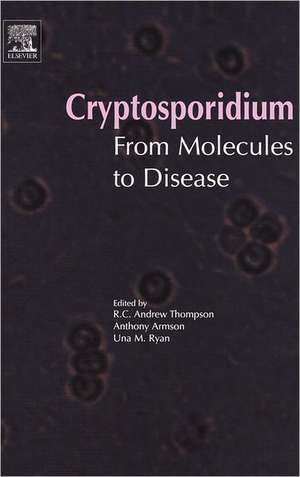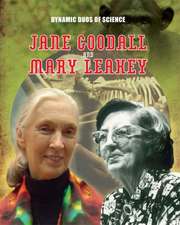Cryptosporidium: From Molecules to Disease
Editat de R.C.A. Thompson, A. Armson, U.M. Ryanen Limba Engleză Hardback – 16 dec 2003
It is thus very timely to bring together in this book the international research community involved to review the major advances in research and identify the important research priorities for the future, thus enabling as wide an audience as possible to benefit from and share in this comprehensive look at Cryptosporidium and cryptosporidiosis.
Preț: 1084.84 lei
Preț vechi: 1486.09 lei
-27% Nou
Puncte Express: 1627
Preț estimativ în valută:
207.59€ • 217.28$ • 172.78£
207.59€ • 217.28$ • 172.78£
Carte tipărită la comandă
Livrare economică 31 martie-14 aprilie
Preluare comenzi: 021 569.72.76
Specificații
ISBN-13: 9780444513519
ISBN-10: 0444513515
Pagini: 468
Dimensiuni: 156 x 234 x 24 mm
Greutate: 0.99 kg
Editura: ELSEVIER SCIENCE
ISBN-10: 0444513515
Pagini: 468
Dimensiuni: 156 x 234 x 24 mm
Greutate: 0.99 kg
Editura: ELSEVIER SCIENCE
Cuprins
Preface (A. Thompson). Introduction: Cryptosporidium: from molecules to disease (G. Meinke). Cryptosporidiosis - Aetiology, Infectivity and Pathogenesis. Cryptosporidium: they probably taste like chicken (S.J. Upton). Cryptosporidium: from molecules to disease (R. Fayer). Cryptosporidium parvum: infectivity, pathogenesis and the host-parasite relationship (C.L. Chappell, P.C. Okhuysen et al.). What is the clinical and zoonotic significance of cryptosporidiosis in domestic animals and wildlife (M.E. Olson, B.J. Ralston et al.). Extended Abstracts. Control of Cryptosporidium parvum infection and the role of IL-4 in two strains of inbred mice (C.A. Notley, S.A.C. Mcdonald et al.). Human peripheral CD8+CD103+ T-lymphocyte transmigration through inverted Cryptosporidium parvum sporozoite infected HCT-8 cell monolayers (G. Gargala, A. Delaunay et al.). Cryptosporidium parvum volunteer study: infectivity and immunity(C.L. Chappell, P.C. Okhuysen et al.). Transmission of human genotype 1 Cryptosporidium parvum into lambs (M. Giles, D.C. Warhurs et al.). A longitudinal study of Cryptosporidium prevalence and its impact on performance in feedlot cattle (B.J. Ralston, M.E. Olson et al.). Identification and characterisation of the antigenic CPA135 protein(F. Tosini, A. Agnoli et al.). A permanent method for detecting
Cryptosporidium parvum life cycle stages in in vitro culture (H.V. Smith, R.A. Nichols et al.).
Successful cultivation of Cryptosporidium reveals previously undescribed Gregarino-like developmental stages (N. Hijjawi, B.P. Meloni et al.). Epidemiology and species differentiation. Cryptosporidium as a public health challenge (R.M. Chalmers). The zoonotic potential of Cyptosporidium (R.C.A. Thompson). Molecular epidemiology of human cryptosporidiosis (L. Xiao, C. Bern et al.). Molecular characterisation and taxonomy of Cryptosporidium (U.M. Ryan). Extended Abstracts. Antigenic differences in Cryptosporidium parvum oocysts: the "Iowa strain" enigma (A. Ronald, S. Birrell et al.). Antigenic analysis of Cryptosporidium parvum isolates of human and animal origin (A. Ronald, J.E. O'Grady, H.V. Smith). Typing of Cryptosporidium parvum oocysts using phage-display technology (C. Lima, H.V. Smith et al.). High resolution genotyping of Cryptosporidium by mutation scanning (A. El-Osta, Y. Zhu et al.). Evaluation of oocyst DNA extraction methods using real-time PCR (P. Monis, A. Keegan et al.). Differentiation of Cryptosporidium parvum subtypes by a novel microsatelite-telomere PCR with page (S.A. Blasdall, J.E. Ongerth, N. Ashbolt). Genotypic variation of Cryptosporidium organisms recovered from persons living in Kenya, Malawi, Vietnam and Brazil (W. Gatei, C.A. Hart et al.). Epidemiological surveys of cryptosporidiosis in Thai orphans (M. Mungthin, T. Naaglor et al.). Cryptosporidium and Cyclospora-associated diarrhea in Kathmandu, Nepal (K. Ono, K. Kimura et al.). Ecology of zoonotic cryptosporidiosis in watersheds containing cattle farming operations (T.K. Graczyk, C.J. Shiff et al.). Identifying variation among human, animal and environmental isolates of Cryptosporidium (R.M. Chalmers). Cryptosporidium in eastern grey kangaroos Macropus giganteus (M.L. Power, M.B. Slade et al.). Viability and infectivity. Detection of infectious Cryptosporidium parvum oocysts in environmental water samples (G.D. Di Giovanni, R. Aboytes). Measuring inactivation of Cryptosporidium parvum by in vitro cell culture(P.A. Rochelle, A.A Mofidi et al.). In vitro cultivation and development of Cryptosporidium in cell culture (N. Hijjawi). Extended Abstracts. The use of cell culture and real-time PCR to assess disinfection of Cryptosporidium parvum(A. Keegan, S. Gelonese et al.). Inactivation of Cryptosporidium parvum oocysts by low pressure UV-light (P. Karanis, D. Schoenen, O. Hoyer). Detection of viable oocysts of Cryptosporidium parvum by nucleic acid sequence-based amplification (NASBA) (C.J. Lowery, J.E. Moore et al.). Flow cytometric evaluation of Cryptosporidium parvum oocyst viability (A. Delaunaya, G. Gargalaa et al.). Cryptosporidium and the environment. The public health significance of Cryptosporidium in the environment (P.T. Monis, R.M. Chalmers). Assessing variables in disinfection parameters of Cryptosporidium parvum oocysts (M.M. Marshall). Detection of Cryptosporidium oocysts in water matrices (F.W. Schaefer III). Microbiological health criteria for Cryptosporidium (C. Ferguson, G. Medema et al.). Case-control studies of sporadic Cryptosporidiosis in Melbourne and Adelaide (B.R. Robertson, C.K. Fairley et al.). The DWI licensed inter-laboratory Cryptosporidium proficiency scheme (CRYPTS) (H.V. Smith, B.M. Campbell, J. Peet). Extended Abstracts. Detection of Cryptosporidium spp. via fluorescent in situ hybridisation: novel approaches of background reduction and signal enhancement (M. Dorsch, D.A. Veal). The risk of Cryptosporidium to Sydney's drinking water supply(P. Cox, P. Hawkins et al.). Outbreak of waterborne Cryptosporidiosis at North Battleford, SK, Canada (P. Wallis, N. Bounsombath et al.). Event sampling for Cryptosporidium and Giardia in
South Australian water sources (S. Hayes, P. Dobson et al.). Drinking water regulations for Cryptosporidum in England and Wales (D. Drury, A. Lloyd). Why Cryptosporidium research for large water supplies: investigations in the Lake Mornos, the big water reservoir of Greater Athens, Greece (P. Karanis, C. Papadopoulou et al.). NATA accreditation of laboratories testing water for the presence of parasitic protozoa (T.G. Orlova). Use of ferric sulfate flocculation method for the recovery of Cryptosporidium oocysts from drinking water (P. Karanis, A. Kimura). A sensitive, semi-quantitative direct PCR-RFLP assay for simultaneous detection of five Cryptosporidium species in treated drinking waters and mineral waters (R.A.B. Nichols, C.A. Paton et al.). The incidence of Cryptosporidium and Giardia in private water supplies in the United Kingdom (J. Watkins, D. Drury). The problem with Cryptosporidium in swimming pools(G. Nichols, R. Chalmers et al.). Cryptosporidium parvum oocyst recovery using immunomagnetisable separation (C.A. Paton, D.E. Kelsey et al.). Significance of enhanced morphological detection of Cryptosporidium sp. oocysts in water concentrates using DAPI and immunofluorescence microscopy (H.V. Smith, B.M. Campbell et al.). Surveillance of Cryptosporidiosis: progressive approaches (G. Nichols, J. McLauchlin et al.). Cryptosporidium and the environment - overview and summary(R.M. Chalmers, P. Monis). Cryptosporidium - chemotherapy. A review of chemotherapeutic approaches to the treatment of Cryptosporidium (A. Armson, J.A. Reynoldson, R.C.A. Thompson). Extended Abstracts. An examination of the activity of the dinitroanilines on Cryptosporidium parvum using in vitro, in vivo and target expression methods (A. Armson, R.C.A. Thompson et al.). Nitazoxanide in the treatment of cryptosporidiosis (J.F. Rossignol, A. Youb et al.). The application of quantitative-PCR for high throughput screening of novel compounds against Cryptosporidium parvum in vitro and their subsequent IC50 determination (L. Pallant, L. Macdonald et al.). Development of a standard method to recover protozoan parasites from soft fruit and salad vegetables (C.A. Paton, N. Wilkinson et al.). How safe is drinking water in primary schools? (U. Chukohtuad, V. Suphiphat). Synthesis. Facilitators: (P. O'Donoghue, S. Upton et al.).
Cryptosporidium parvum life cycle stages in in vitro culture (H.V. Smith, R.A. Nichols et al.).
Successful cultivation of Cryptosporidium reveals previously undescribed Gregarino-like developmental stages (N. Hijjawi, B.P. Meloni et al.). Epidemiology and species differentiation. Cryptosporidium as a public health challenge (R.M. Chalmers). The zoonotic potential of Cyptosporidium (R.C.A. Thompson). Molecular epidemiology of human cryptosporidiosis (L. Xiao, C. Bern et al.). Molecular characterisation and taxonomy of Cryptosporidium (U.M. Ryan). Extended Abstracts. Antigenic differences in Cryptosporidium parvum oocysts: the "Iowa strain" enigma (A. Ronald, S. Birrell et al.). Antigenic analysis of Cryptosporidium parvum isolates of human and animal origin (A. Ronald, J.E. O'Grady, H.V. Smith). Typing of Cryptosporidium parvum oocysts using phage-display technology (C. Lima, H.V. Smith et al.). High resolution genotyping of Cryptosporidium by mutation scanning (A. El-Osta, Y. Zhu et al.). Evaluation of oocyst DNA extraction methods using real-time PCR (P. Monis, A. Keegan et al.). Differentiation of Cryptosporidium parvum subtypes by a novel microsatelite-telomere PCR with page (S.A. Blasdall, J.E. Ongerth, N. Ashbolt). Genotypic variation of Cryptosporidium organisms recovered from persons living in Kenya, Malawi, Vietnam and Brazil (W. Gatei, C.A. Hart et al.). Epidemiological surveys of cryptosporidiosis in Thai orphans (M. Mungthin, T. Naaglor et al.). Cryptosporidium and Cyclospora-associated diarrhea in Kathmandu, Nepal (K. Ono, K. Kimura et al.). Ecology of zoonotic cryptosporidiosis in watersheds containing cattle farming operations (T.K. Graczyk, C.J. Shiff et al.). Identifying variation among human, animal and environmental isolates of Cryptosporidium (R.M. Chalmers). Cryptosporidium in eastern grey kangaroos Macropus giganteus (M.L. Power, M.B. Slade et al.). Viability and infectivity. Detection of infectious Cryptosporidium parvum oocysts in environmental water samples (G.D. Di Giovanni, R. Aboytes). Measuring inactivation of Cryptosporidium parvum by in vitro cell culture(P.A. Rochelle, A.A Mofidi et al.). In vitro cultivation and development of Cryptosporidium in cell culture (N. Hijjawi). Extended Abstracts. The use of cell culture and real-time PCR to assess disinfection of Cryptosporidium parvum(A. Keegan, S. Gelonese et al.). Inactivation of Cryptosporidium parvum oocysts by low pressure UV-light (P. Karanis, D. Schoenen, O. Hoyer). Detection of viable oocysts of Cryptosporidium parvum by nucleic acid sequence-based amplification (NASBA) (C.J. Lowery, J.E. Moore et al.). Flow cytometric evaluation of Cryptosporidium parvum oocyst viability (A. Delaunaya, G. Gargalaa et al.). Cryptosporidium and the environment. The public health significance of Cryptosporidium in the environment (P.T. Monis, R.M. Chalmers). Assessing variables in disinfection parameters of Cryptosporidium parvum oocysts (M.M. Marshall). Detection of Cryptosporidium oocysts in water matrices (F.W. Schaefer III). Microbiological health criteria for Cryptosporidium (C. Ferguson, G. Medema et al.). Case-control studies of sporadic Cryptosporidiosis in Melbourne and Adelaide (B.R. Robertson, C.K. Fairley et al.). The DWI licensed inter-laboratory Cryptosporidium proficiency scheme (CRYPTS) (H.V. Smith, B.M. Campbell, J. Peet). Extended Abstracts. Detection of Cryptosporidium spp. via fluorescent in situ hybridisation: novel approaches of background reduction and signal enhancement (M. Dorsch, D.A. Veal). The risk of Cryptosporidium to Sydney's drinking water supply(P. Cox, P. Hawkins et al.). Outbreak of waterborne Cryptosporidiosis at North Battleford, SK, Canada (P. Wallis, N. Bounsombath et al.). Event sampling for Cryptosporidium and Giardia in
South Australian water sources (S. Hayes, P. Dobson et al.). Drinking water regulations for Cryptosporidum in England and Wales (D. Drury, A. Lloyd). Why Cryptosporidium research for large water supplies: investigations in the Lake Mornos, the big water reservoir of Greater Athens, Greece (P. Karanis, C. Papadopoulou et al.). NATA accreditation of laboratories testing water for the presence of parasitic protozoa (T.G. Orlova). Use of ferric sulfate flocculation method for the recovery of Cryptosporidium oocysts from drinking water (P. Karanis, A. Kimura). A sensitive, semi-quantitative direct PCR-RFLP assay for simultaneous detection of five Cryptosporidium species in treated drinking waters and mineral waters (R.A.B. Nichols, C.A. Paton et al.). The incidence of Cryptosporidium and Giardia in private water supplies in the United Kingdom (J. Watkins, D. Drury). The problem with Cryptosporidium in swimming pools(G. Nichols, R. Chalmers et al.). Cryptosporidium parvum oocyst recovery using immunomagnetisable separation (C.A. Paton, D.E. Kelsey et al.). Significance of enhanced morphological detection of Cryptosporidium sp. oocysts in water concentrates using DAPI and immunofluorescence microscopy (H.V. Smith, B.M. Campbell et al.). Surveillance of Cryptosporidiosis: progressive approaches (G. Nichols, J. McLauchlin et al.). Cryptosporidium and the environment - overview and summary(R.M. Chalmers, P. Monis). Cryptosporidium - chemotherapy. A review of chemotherapeutic approaches to the treatment of Cryptosporidium (A. Armson, J.A. Reynoldson, R.C.A. Thompson). Extended Abstracts. An examination of the activity of the dinitroanilines on Cryptosporidium parvum using in vitro, in vivo and target expression methods (A. Armson, R.C.A. Thompson et al.). Nitazoxanide in the treatment of cryptosporidiosis (J.F. Rossignol, A. Youb et al.). The application of quantitative-PCR for high throughput screening of novel compounds against Cryptosporidium parvum in vitro and their subsequent IC50 determination (L. Pallant, L. Macdonald et al.). Development of a standard method to recover protozoan parasites from soft fruit and salad vegetables (C.A. Paton, N. Wilkinson et al.). How safe is drinking water in primary schools? (U. Chukohtuad, V. Suphiphat). Synthesis. Facilitators: (P. O'Donoghue, S. Upton et al.).





